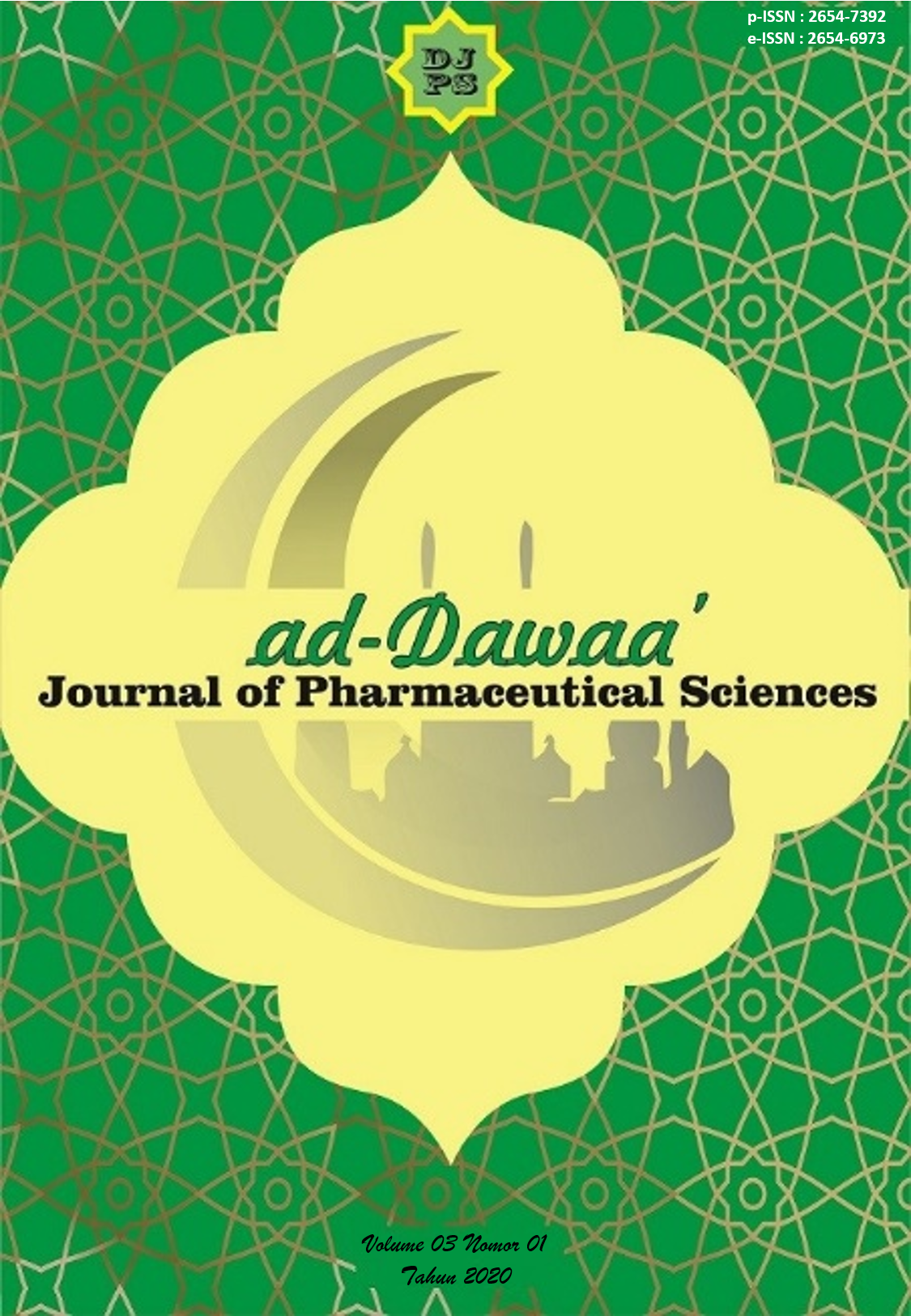Study of Prescription Screening for Administrative and Pharmaceutical Aspects at CS Farma Pharmacy in the Period June-December 2018
Abstract
Incomplete prescribing can be one of the causes of medication errors in patients. This incident can be avoided by screening prescriptions by pharmacists at pharmacies which include administrative and pharmaceutical studies. The purpose of this study was to determine the administrative and pharmaceutical prescription completeness in June-December 2018 at CS Farma Pharmacy. The research method was descriptive nonexperimental with retrospective data collection. Samples were collected by simple random sampling technique and obtained 385 pieces of recipes that have met the inclusion criteria. The result shows that the completeness of administrative prescriptions consisted of: patient name 99,22%, patient age 88,05%, sex 9,09%, body weight 0%, doctor's name 3,64%, doctor's SIP 0% , prescription date 97,92%, doctor's address 100%, doctor's telephone number 0,26% and doctor's initial 6,23%. Pharmaceutical aspects consisted of: dosage form 69,61%, dosage strength 57,66%, drug stability 100% and incompatibility 100%. It can be concluded that the prescription in CS Farma Pharmacy on June-December 2018 was not complete administratively and pharmaceutically yet, based on Permenkes No.73 In 2016.Downloads
References
Ali, M. A., Neelkantreddy, A., Riyaz, & Abdul Sayeed, M. (2014). A study on determination of prescription writing errors in outpatient department of pediatrics in a teaching hospital. Int J Adv Pharmacy Med Bioallied Sci, 2(2), 74-77.
Ansari, M., & Neupane, D. (2009). Study on determination of errors in prescription writing: A semielectronic perspective. Kathmandu University Medical Journal, 7(3), 238-241. doi:DOI: 10.3126/kumj.v7i3.2730
Ather, A., Neelkantreddy, P., Anand, G., Manjunath, G., Vishwanath, J., & Riyaz, M. (2013). A Study on Determination of Prescription Writing Errors in out Patient Department of Medicine in a Teaching Hospital. Indian Journal of Pharmacy Practice, 6(2), 21-24.
Cholisoh, Z. (2019). Kualitas Penulisan Resep untuk Pasien Pediatri di Rumah. The 10th University Research Colloqium 2019.
Ismaya, N. A., Tho, I. L., & Fathoni, M. I. (2019). Gambaran Kelengkapan Resep Secara Administratif Dan Farmasetik Di Apotek K24 Pos Pengumben. Edu Masda Journal, 2(3), 148-157.
Keputusan Menteri Kesehatan Republik Indonesia Nomor 1027/MENKES/SK/IX/ 2004. (2004). Standar Pelayanan Kefarmasian Di Apotek. Indonesia.
Khairurrijal, M. A., & Putriana, N. A. (2017). Review : Medication Erorr Pada Tahap Prescribing, Transcribing. Majalah Farmasetika, 2(4), 8-13. doi:DOI: 10.24198/farmasetika.v2i4.15020
Marini, Iswahyudi, & Wijianto, B. (2013). Analisa Penulisan Kelengkapan Resep Dari Aspek Kelengkapan Resep Di Apotek Kota Pontianak Pada Tahun 2012. Program Studi Farmasi Fakultas Kedokteran Universitas Tanjungpura Pontianak.
Megawati, F., & Santoso, P. (2017). Pengkajian Resep Secara Administratif Berdasarkan Peraturan Menteri Kesehatan RI No 35 Tahun 2014 Pada Resep Dokter Spesialis Kandungan Di Apotek Sthira Dhipa. Medicamento, 3(1), 12-16.
Peraturan Menteri Kesehatan Republik Indonesia Nomor 73 Tahun 2016. (2016). Standar Pelayanan Kefarmasian Di Apotek. Jakarta.
Pratiwi, D., M, N. R., & Pratiwi, D. R. (2018). Analisis Kelengkapan Administratif Resep di Apotek Bhumi Bunda Ketejer Praya, Lombok Tengah. Jurnal Kesehatan Qamarul Huda, 6(1), 6-11.
Rahmawati, F., & R.A., O. (2002). Kajian Penulisan Resep: Tinjauan Aspek Legalitas Dan Kelengkapan Resep Di Apotek-Apotek Kotamadya Yogyakarta. Majalah Farmasi Indonesia, 13(2), 86-94.
Sheikh, D., Mateti, U. V., Kabekkodu, S., & Sanal, T. (2017). Assessment of medication errors and adherence to WHO prescription writing guidelines in a tertiary care hospital. Future Journal of Pharmaceutical Sciences, 3, 60-64. doi:DOI: 10.1016/j.fjps.2017.03.001
Once an article was published in the journal, the author(s) are:
- granted to the journal right licensed under Creative Commons License Attribution that allows others to share the work with an acknowledgement of the work's authorship.
- permitted to publish their work online in third parties as it can lead to wider dissemination of the work.
- continue to be the copyright owner and allow the journal to publish the article with the CC BY-SA license
- receiving a DOI (Digital Object Identifier) of the work.




1.png)